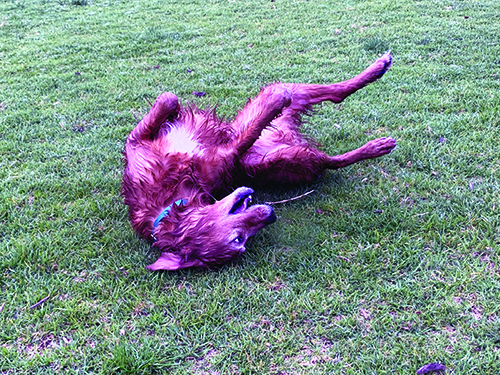
The walk starts innocently enough. Then you realize your dog, who has scampered ahead of you, has hit the ground and is writhing gleefully atop an odoriferous animal carcass or some excrement of unknown origin.
Sound, or, perhaps more accurately, smell familiar?
Most every dog owner can recount tales of their canine companions having rolled in something stinky, often at the most inopportune time, like shortly following a bath. Why do dogs do this? And why do they always choose odors that are maximally offensive to us, like dead animals or poop, and not the lovely lavender patch?
Truth is, we don’t specifically know, but there are several theories out there:
Stink facilitates stealth? Many have suggested the behavior is an evolutionary carryover from dogs’ days as wild predators, noting the tendency of wolves to roll in feces and atop animal carcasses. Some biologists have suggested this behavior could be designed to assist with hunting by masking or camouflaging a dog’s own predator scent in an effort to more effectively sneak up on prey.
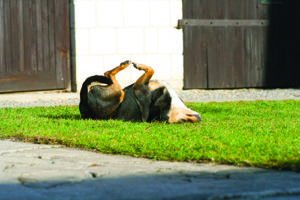
Stanley Coren, Ph.D., author of several books about dog behavior and “Canine Corner” columnist for Psychology Today, notes this idea makes both evolutionary and adaptive sense. He explained that if an antelope smelled the scent of a wild dog, jackal, or wolf nearby, the antelope would likely bolt and run for safety. But, because antelopes are used to the smell of their own droppings and carrion (decaying flesh) is common on open plains, “prey animals are less likely to be frightened or suspicious of a hairy thing coated with that smell,” he wrote in one of his columns.
Renowned behaviorist and author Patricia McConnell, Ph.D., is skeptical about that theory. In a 2015 blog post exploring potential reasons why dogs roll in substances that we find to be highly unsavory, she points out how “most prey animals are highly visual, and use sight and sound to be on alert for predators.”
She argues that, first, hoofed animals have greater peripheral vision due to the placement of their eyes, and they have ears that “swivel around like mobile satellite dishes.” If a prey animal’s sense of smell is adept enough to recognize predator scent, says McConnell, the animal can likely recognize that scent even when layered with the similar scent of its same species, or that of carrion from the surrounding area.
Finally, some scientists have noted that, while wolves sometimes ambush their targets while hunting, it’s more common for them to chase down prey, lessening the need for as stealthy an approach.
Advertising access to resources? Another theory is that rolling around in feces or atop a carcass is a way to share valuable information with other dogs. Researchers at Wolf Park in Battleground, Ind., have found that wolves often followed a scent to its source after smelling it on a pack-mate. In the wild, returning to the pack awash in eau de dead animal might help lead others to a source of food. At the very least, it advertises one’s ability to access a valuable resource, which can make for an attractive mate.
Is it about the dog’s scent? A lesser-supported hypothesis is that the rolling behavior might be to distribute the dog’s scent onto the stinky item, rather than the other way around. This seems like a largely ineffective method compared to marking with urine or feces, especially when dealing with matter so pungent, so experts believe this is unlikely.
It’s fun?! There’s no mistaking a dog’s sheer delight as they roll about, often oblivious to our despair. Some scientists believe the behavior triggers a rush of dopamine, a neurotransmitter involved in reward and pleasure. While the behavior likely served an important function in dogs’ evolutionary past, for today’s domesticated dogs, that function has vanished, but the behavior remains because it feels good.
My own dog is known for his daily exuberant rolls in the park, usually commencing after a few happy retrieves of a favorite ball. He’ll trot a few steps away, lie down, and proceed to flip belly up, legs flailing as his body lurches side to side. His tongue hangs from his mouth and he snorts in delight, looking absolutely joyful. To me the message seems clear: Let the good times roll!
WHAT CAN YOU DO?
As with many things in dog training, an ounce of prevention is worth a pound of cure. If you’re likely to encounter nasty things in which your dog will want to roll, keep him on-leash! If using a long line or allowing your dog off leash, pay attention to your dog! Time with your dog, especially when you’ve chosen to let him off leash, should be spent engaged with your dog, not your mobile device.
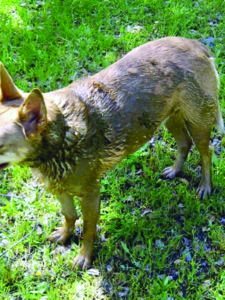
1. Practice name recognition. Teach your dog to quickly orient to you when you say his name. Begin this behavior in a familiar area with few to no distractions and work your way up. With your dog on leash, casually maneuver so that you’re behind him. Say his name. When he turns to look at you, mark the moment using a clicker or marker word such as “Yes!” and offer a treat paired with praise and enjoyable petting.
If he doesn’t turn around, repeat his name up to two more times, using a happy, upbeat tone of voice. If he hasn’t turned around after three tries, playfully tap him on the rear to get his attention, praising him enthusiastically as he turns around. From there, evaluate the situation to determine what made the behavior so challenging. Likely, he was distracted by something and the “pull” of the distraction was too great.
Before trying again, make a point to move away from the distraction, stacking the deck in your favor that he’ll be able to respond to his name within three tries. The goal is to make it easy for him to be correct. The more we can reward the desired response, the more we’ll see the desired response and the faster it will happen.
When this behavior is solid, the dog should happily turn toward you, if not return to you, in anticipation of a reward. Use this behavior randomly while on walks to build and maintain a strong reinforcement history. It’s a great way to keep a dog out of trouble, especially when he’s off leash.
When my dog appears to be taking interest in something – especially if I can’t see what it is – I use his name (or formal recall cue) to call him back to me and we approach together. If the item is on the “approved list” he’s free to check it out. If not, I’ve prevented an unwanted situation.
2. Teach a solid recall. As a trainer, I can’t stress this enough. The single most important behavior you can teach your dog is to reliably come when called. A dog who comes when called is more likely to earn the freedom to safely experience off-leash adventures in appropriate settings and is overall safer in general.
Enjoying some off-leash time along the river? Notice your dog sniffing a rotting fish along the shore? Call her back to you before she escalates her sniffing to the roll of doom! (See “Rocket Recall,” WDJ September 2015; “Games for Building a Reliable Recall,” September 2014, and “Training Your Dog to Execute an ‘Extremely Fast’ Reliable Recall,” September 2012.)
3. Reward all natural check-ins. As you walk with your dog, especially when he’s up ahead of you via a long line or when he’s off leash, pay attention to the moments when he pauses and looks back at you or chooses to return without being called. Reinforcing these natural check-ins with praise, petting, and the frequent addition of treats reinforces the idea that you’re walking together.
The more you’re walking in partnership with your dog, the greater the chance he can still happily explore the environment without becoming so fixated on any one thing (like something gross he wants to roll in) that he ignores your attempts to redirect his attention or call him away from something gross.
4. Anticipate problem areas. If you can predict where or when your dog is likely to roll in something foul, don’t give him the opportunity to do so. Maybe it’s the parkway flowerbed three doors down, the one the neighborhood cats routinely use as a litter box.
If you’ve been burned by your dog’s stop, drop, and roll antics, don’t let him pull you toward the danger zone, even if it seems he only wants an innocent sniff. Keep your dog’s attention on you as you approach and pass the flowerbed of doom using upbeat conversation and praise paired with treats and a favorite toy as necessary. Make not stopping to look for cat poop in which to roll more fun than doing so.
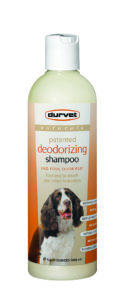
If you find yourself needing to bathe an especially stinky dog, we recommend the age-old recipe for de-skunking a dog, as the combination of the two main ingredients effectively break down natural odors. Mix one quart of 3% hydrogen peroxide with ¼ cup baking soda in a bucket or large bowl. Stir in a teaspoon or two of grease-cutting liquid soap; using a grease-cutting soap is important because many foul-smelling, organic substances are oily. Make sure the hydrogen peroxide is fresh and fizzy; it’s an unstable compound that, over time, will break down and lose its effectiveness as an odor neutralizer.
Rub the mixture into the dog’s coat, avoiding the eyes and lips (it stings!), and let it sit briefly before rinsing. Don’t wait too long to rinse, as the peroxide can bleach the coat. Do not attempt to store any leftover formula; the combination of ingredients can explode if left in a bottle.
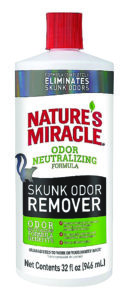
There are also several deodorizing shampoos available commercially. We’ve heard good things about Durvet Naturals Basics Deodorizing Shampoo and Nature’s Miracle Skunk Odor Remover, which works on a variety of odors, not just skunk spray. The Nature’s Miracle product is also safe to use on clothing and carpet.
As a dog owner, it’s never a bad idea to keep an odor-removing product on hand – just in case! – so they don’t have to be left to spread the stink around while you are out buying something to get it off of them!
DAMAGE CONTROL
If your dog does manage to hit the deck and adorn herself in something gross, don’t get mad at her. After all, she’s engaging in perfectly normal dog behavior, and we, as her handler, gave her the opportunity, even if by accident.
Instead, focus on interrupting the behavior as quickly as possible to minimize the damage, and be sure to praise as soon as she’s on her feet. This can take great self-control, especially when you’re now standing next to a stinky, manure-covered canine, but it’s important to reward her compliance.
It’s always a good idea to keep a cleanup kit in your car. Dogs will be dogs, and we never know when an innocent walk in the park will result in a muddy or stink-covered canine. My dogs ride in crates, which makes it super easy to contain a mess.
If that’s not an option, a couple of towels, a large jug of water, and an old sheet to fully protect the car’s interior will go a long way toward getting everyone home – or to the nearest groomer – as cleanly as possible. Another great suggestion is to add an old t-shirt to the cleanup kit and make the offending dirty dog wear it as a barrier between the grossness and your car.
Stephanie Colman is a writer and dog trainer in Southern California. She works in the puppy department at Guide Dogs of America, helping to recruit and manage volunteer puppy raisers.


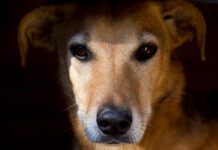
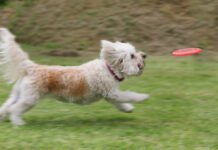
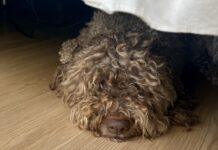

Thank you!!!!
I question the camouflage theory as well because in my experience dogs roll in all kinds of poop. Buzzards, Fox, as well as prey animals. In fact they do not roll in prey poop as often, they eat it. I never see my dogs roll in manure or deer poop. Some roll, some eat. Maybe for them it is not at all offensive and is a matter of taste, in flavor or odor.
Regardless I try to prevent it, and grudgingly try to wash it off when it happens. It is obviously a pleasure for them and so what can ya do?
“Stop, drop and roll” sure means something different to dogs than to humans! My heeler seems to think it’s the funnest thing in the world. I see that shoulder start to sag and before I know it we’re in for a smelly old time.
It could also be that the smelly fragrance enhances a dog’s status in the pack!
I disagree about using shampoos, first because lots of western dogs are given baths far too often due to over-fastidious owners, second because they ruin the dogs’ skin, third because the dogs will roll again to remove the offending smell (the perfume that oversensitive owners do love).
My own dogs (4 of them) roll in smelly things too. Here’s the best piece of advice I’ve ever been given – by an experienced vet tech.
Use half warm/tepid water, half white vinegar. Dip a small towel in the mix and lavishly clean the DIRTY part of the dog with it (certainly not the whole dog). It takes a few hours for the vinegar to really remove the smell. In the meantime, the dog will smell of… vinegar with traces of what it rolled in in the first place.
You’ll have to be extremely careful around the dog’s ears, eyes, genitals etc. of course!
If your nose is wrinkling at the mere thought of not drenching your poor longsuffering dog in rose-perfumed shampoo, well, I’m sorry to say so, but people who can’t stand smells that don’t come from bottles and chemicals shouldn’t have dogs. Only my humble opinion. 🙂
The other day I caught my Redbone Coonhound rolling on a dead mole. It wasn’t stinky but still….Sheesh. Then there’s the fact that the neighbor’s put stink manure on their yard and when we walk now both want to eat it . Disgusting. At least I now have a better understanding of why dogs like roll in the smell. Makes sense.
Thanks for this article. My dog is always rolling in things that smell so bad but now I understand why.
My dog was rolling in a fish offal one day… best experience in my life